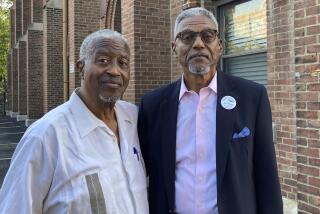Chernobyl: Grim New Assessment : Fallout: Study says ‘hundreds of times’ more people may have suffered fatal exposure than had been thought.
- Share via
MOSCOW — Many more people were bombarded by high doses of radiation from the Chernobyl accident than officially reported, and even those who received small doses are in jeopardy, a pioneering Russian-American study has found.
“We have gotten a completely new picture of the medical consequences of the Chernobyl catastrophe,” said Dr. Vladimir M. Lupandin, a Russian physician who was one of the leading investigators in the survey.
“The situation is worse in human health terms than the International Atomic Energy Agency said after its six-day survey, worse than the former Soviet Health Ministry said,” commented Francis Macy, a psychologist at the Center for U.S.-U.S.S.R. Initiatives in San Francisco and an American participant in the study.
Lupandin, who interviewed health professionals serving communities dusted with fallout, said as many as 10,000 to 12,000 evacuees from just one of the districts of Belarus lying within a 30-kilometer (18.5-mile) radius of the power plant showed symptoms of heavy irradiation after the reactor explosion and fire in April, 1986.
Soviet public health officials and IAEA experts have maintained that only around 100 people were hit with large radiation doses. Lupandin said the very low figure was patently absurd, but fully understandable.
“The KGB told doctors not to tell anyone anything,” Lupandin told a Moscow conference of grass-roots environmental activists.
IAEA researchers were fed blatantly false information by officials they spoke to, or even by their interpreters, he added.
“It is only with the collapse of the Soviet Union that the true story is emerging, that physicians will speak freely,” the doctor said. The actual number of people who suffered massive, potentially fatal exposure to the radiation loosed by Chernobyl “may be hundreds of times, even a thousand times,” greater than previously thought, he said.
To buttress his point, Lupandin tracked down 235 people who originally lived in the Belarus village of Ulasy--less than two miles from Chernobyl, which is just across the Ukraine border--and who were resettled after the village was evacuated.
Thirty-five of the relocated villagers, although they were in the prime of life and felt fine for three years after the nuclear accident, are now dead of cancer.
Of the survivors, many now suffer from goiter or diabetes, Lupandin said.
The leaders of the 13-month research project said it supports the pessimistic forecasts of John W. Gofman, professor emeritus of medical physics at UC Berkeley, that the health of at least 1 million people has been menaced because Chernobyl exposed them to prolonged, low-level radiation.
That finding flies in the face of statements by authorities in both the Russian and IAEA bureaucracies, who assert that there is no such thing as “chronic radiation illness” caused by the Chernobyl accident, Lupandin said.
He said that in western areas of the Russian region of Bryansk, which were irradiated by fallout, the chief pediatrician of the Russian Health Ministry reported that half of the children show signs of chronic radiation sickness, such as lymph gland inflammation, digestive tract and kidney failure, and anemia.
In all affected regions, Lupandin said, many children were found who suffer from chronic fatigue and a low count of red blood cells--symptoms that the researcher, affiliated with the Institute of Sociology of the Russian Academy of Sciences, said are compatible with “chronic radiation illness.”
Despite the suspicion of some experts that exposure to low but persistent levels of radiation is dangerous for human health, at least 2 million people in Belarus and an estimated 4 million Ukrainians still live in areas of heightened radioactivity, Macy said.
The independent survey’s findings will provide new ammunition for the foes of nuclear energy, who are concerned that the breakup of centralized Soviet administrative links makes Soviet-built nuclear power plants doubly dangerous.
Six years after the fact, a large swath of Central Europe remains a “radioactive jungle” because of Chernobyl, Lupandin said in his written report.
“Here with each step, there is danger: One can sit down on a patch of strontium, drink a glass of milk with cesium-137, eat potatoes with plutonium and taste mushrooms whose level of irradiation makes them radioactive waste,” he wrote.
Despite the efforts of U.S. and Russian scientists, the exact human toll of the disaster is still unknown, Lupandin said, in part because it has been impossible to learn the fate of all evacuees and of the Soviet soldiers and workers who were brought in to suppress the radiation danger and who were withdrawn later.
Soviet authorities admitted that 32 people were killed in the reactor explosion and fire. But Vyacheslav S. Konovalov, a Ukrainian biologist, told the Moscow conference that 8,500 of the men who toiled after the accident at Chernobyl to entomb the No. 4 reactor in concrete and quench hot spots of radiation have since died.
More to Read
Sign up for Essential California
The most important California stories and recommendations in your inbox every morning.
You may occasionally receive promotional content from the Los Angeles Times.










